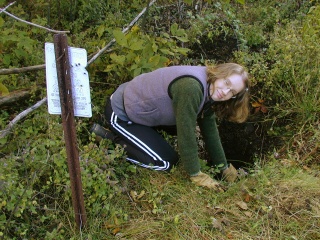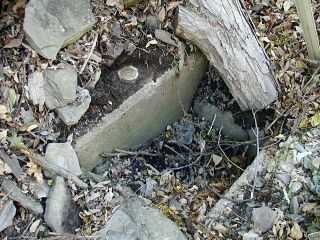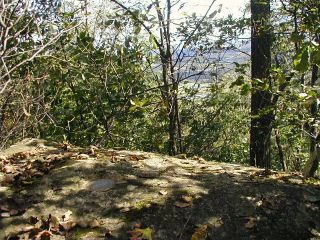This early autumn day was perfect for a lengthy hike with a benchmark recovery as our goal. Our approach took us from Routes 6 & 92 in Tunkhannock to Lane Hill Road, from which we continued onto Hobbs Road. We parked at the end of the pavement, where a cable crosses the road, and hiked the remaining one and one-eighth mile on steep, well-defined trails to the summit of Osterhout Mountain. Once at the top we spotted a woods road joining our trail from another direction, which may provide easier access to the summit. We didn’t investigate it at the time and cannot find any indication of this road on topo maps or aerial photographs.
Our initial fears about the station mark being underground were quelled when we saw the depression in the ground near the witness post. It seemed someone had done half our work for us. The station was used at some point after its monumentation and then covered loosely by soil and rock. Digging down another twelve inches was nevertheless required to view the disk. The witness post and sign are still in place and helped further confirm we were excavating the correct spot. It took a bit of work, but the disk was eventually revealed. It is in excellent condition. Before leaving the area, we covered the station to protect the disk and refilled the hole with soil to the level at which we found it.
Both reference marks were found in good condition as described. RM2 is set on a boulder overlooking the valley and was exposed and therefore easy to spot, while RM1 required some digging to locate beneath a layer of soil and leaves. Distances and directions to the station match those given on the datasheet.
As we reported for LY2800, the antenna pole has been destroyed. The airway beacon tower, LY2802, has also been destroyed and the northwest leg, which is referred to in the station description, is entirely missing. In order to update the description, we took a measurement north-northeast to the station from what remains of the east leg of the tower. We found this distance to be 19 feet. While at the summit of Osterhout Mountain, we noticed heavy clouds blowing in, and it began to snow.
After hiking back to the car we followed the historic description to the azimuth mark. The mark was found easily as described, except that the azimuth mark witness post was not located. The disk is in good condition. We took measurements from a nearby powerpole and highway sign to add to our report.


